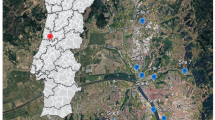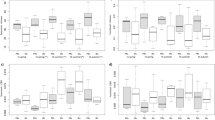Abstract
Second order streams draining areas of virgin forest in Great Smoky Mountains National Park, Tennessee and North Carolina, U.S.A., are compared to those which drain forests logged before the establishment of the park in the 1930's. Water quality of two main study streams (one unlogged and one formerly logged) was compared and the unlogged stream had generally higher levels of dissolved solids and lower levels of suspended particulates than the logged stream. Stream channel characteristics were compared on four logged and four unlogged streams. The unlogged streams had over four times more (by volume) of woody debris and 10 times more material in debris dams than the logged streams. Only minor differences in substrate composition were observed.
Macroinvertebrate samples from the four logged and four unlogged streams showed that the logged streams contained greater numbers of organisms and more taxa. More detailed sampling on the two main study streams showed similar patterns of more individuals and more taxa in the logged stream, as well as differences in the composition of five functional groups. These differences in invertebrate fauna may be due to differences in quantity and quality of leaf litter inputs, although other explanations are also possible.
Similar content being viewed by others
References
American Public Health Association, 1971. Standard methods for the examination of water and wastewater. New York.
Barr, I. F., Goodnight, J. H., Sall, J. P. & Helwig, J. T., 1976. Users guide to SAS76. SAS Inst. Inc. Raleigh, N.C. 329 pp.
Bilby, R. E. & Likens, G. E., 1980. Importance of organic debris dams in the structure and function of stream ecosystems. Ecology 61: 1107–1113.
Bradford, W. L. & Iwatsubo, R. T., 1978. Water chemistry of the Redwood Creek and Mill Creek Basins, Redwood National Park, Humboldt and Del. Norte Countries, California. USGS Wat. Res. Invest. 78–115.
Coffman, W. P., Cummins, K. W. & Wuycheck, J. C., 1971. Energy flow in a woodland stream ecosystem: 1. Tissue support trophic structure of the autumnal community. Arch. Hydrobiol. 68: 232–276.
Egglishaw, H. J., 1964. The distribution relationship between the bottom fauna and plant detritus in streams. J. anim. Ecol. 33: 463–476.
King, P. B., Neuman, R. B. & Hadley, J. B., 1968. Geology of the Great Smoky Mountains National Park, Tennessee and North Carolina. U.S. geol. Surv. Prof. Paper 587.
King, W., 1937. Notes on the distribution of native speckled and rainbow trout in the streams of Great Smoky Mountains National Park. J. Tenn. Acad. Sci. 12: 351–361.
Lambert, R. S., unpublished. Logging in the Great Smoky Mountains National Park. Rep. for the Superintendent, Great Smoky Mountains National Park.
Likens, G. E., Bormann, F. H. & Johnson, N. M., 1969. Nitrification importance to nutrient losses from a cutover forested ecosystem. Science 163: 1205–1206.
Lowe, R. L., unpublished. Diatom communities from natural and disturbed streams in the Great Smoky Mountains National Park.
Martin, C. W., 1979. Precipitation and streamwater chemistry in an undisturbed forested watershed in New Hampshire. Ecology 60: 36–42.
Mason, J. C., 1976. Evaluating a substrate tray for sampling the invertebrate fauna of small streams, with comment on general sampling problems. Arch. Hydrobiol. 78: 51–76.
Minshall, G. W., 1967. Role of allochthonous detritus in the atrophic structure of a woodland springbrook community. Ecology 48:139–149.
Minshall, G. W. & Minshall, J. N., 1977. Microdistribution of benthic invertebrates in a Rocky Mountain (U.S.A.) stream. Hydrobiologia 55: 231–249.
Pennak, R. W., 1953. Freshwater invertebrates of the United States. The Ronald Press Company, N.Y. 769 pp.
Petersen, R. C. & Cummins, K. W., 1974. Leaf processing in a woodland stream. Freshwat. Biol. 343–368.
Pierce, R. S., Martin, C. W., Reeves, C. C., Likens, G. E. & Borman, F. H., 1972. Nutrient losses from clearcutting in New Hampshire. Am. Wat. Res. Ass. Proc. 14: 285–295.
Rabeni, C. F. & Minshall, G. W., 1977. Factors affecting microdistribution of stream benthic insects. Oikos 29: 33–43.
Sedell, J. R., Triska, F. J. & Triska, N. S., 1975. The processing of conifer and hardwood leaves in two coniferous forest streams. I. Weight loss and associated invertebrates. Verb. int. Ver. Limnol. 19: 1617–1627.
Silsbee, D. G. & Larson, G. L., 1981. Physical, chemical, and bacteriological characteristics of streams in the Great Smoky Mountains National Park. USDI, National Park Service Southeast Region Research/Resour. Manage. Rep. 47: 85 pp.
Suberkropp, K., Klug, M. J. & Cummins, K. W., 1975. Community processing of leaf litter in woodland streams. Verb. int. Ver. Limnol. 19: 1653–1658.
Swanson, F. J., Lienkaemper, G. W. & Sedell, J. R., 1976. History, physical effects, and management implications of large organic debris in Western Oregon streams. USDA Forest Serv. Gen. Tech. Rep. PNW-56.
Triska, F. J. & Sedell, J. R., 1976. Decomposition of four species of leaf litter in response to nitrate manipulation. Ecology 57: 783–792.
Usinger, R. L., 1971. Aquatic insects of California. 508 pp. University of California Press. Berkeley, Calif.
Vitousek, P. M. & Reiners, W. A., 1975. Ecosystem succession and nutrient retention: A hypothesis. Bioscience 25: 376–381.
Whittaker, R. H., 1956. Vegetation of the Great Smoky Mountains. Ecol. Monogr. 26: 1–80.
Author information
Authors and Affiliations
Rights and permissions
About this article
Cite this article
Silsbee, D.G., Larson, G.L. A comparison of streams in logged and unlogged areas of Great Smoky Mountains National Park. Hydrobiologia 102, 99–111 (1983). https://doi.org/10.1007/BF00006073
Received:
Revised:
Accepted:
Published:
Issue Date:
DOI: https://doi.org/10.1007/BF00006073




